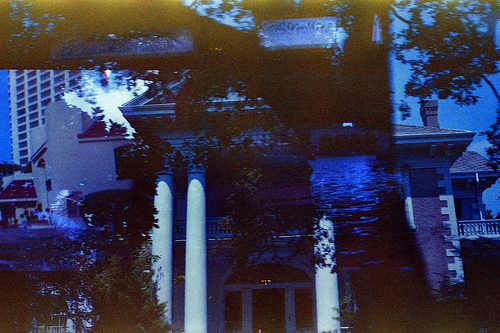The latest series of photos I’ve posted to Flickr are very unusual and need a bit of explanation for anyone to make sense of what they’re seeing. The shortest possible way of describing it is this: you’re looking at double exposures made on film with two different cameras and two decades elapsing between exposures. Make sense? Probably not, so read on for the longer version.
I collect a lot of Vivitar cameras in order to test, photograph, and document them for Camera-Wiki.org where I maintain the Vivitar articles. I bought a camera bag containing a Vivitar v2000 35mm SLR with lenses and accessories at an estate sale in April, 2013. Also in the bag were several rolls of Kodacolor film. All but one of the rolls of film were still sealed in their box. The remaining one was unboxed but the leader was still visible, so I assumed it was unexposed.
Sometime later I obtained a new-in-box Vivitar IC101 Panorama camera. I wanted to shoot with this one right away, so I pulled my film box out of the fridge and looked at my film supply. I had all that shiny new expired film from the recent v2000 purchase. I selected the open roll and loaded it into the IC101. I shot a series of panoramic shots of the Las Colinas canals and a few shots of scenes in Deep Ellum near downtown Dallas. I dropped the film off at The Color Lab for processing, where Robert noted the film can artwork dated the film to the mid 1980s.
I picked up the film later and was surprised to see a series of double exposures. The owner of the Vivitar v2000 had shot the film and rewound it only partially, leaving the leader sticking out, then returned it to the camera bag where it stayed for 25 or so years until I found it at the estate sale and shot the second set of exposures on the same film.
The earlier set of exposure were full frame 36mm x 24mm shots taken at a now defunct water park in Galveston, TX called Sea-Arama Marineworld. There are also a few shots of nearby historic architecture in Galveston. These shots were superimposed with my recent shots of Las Colinas and Deep Ellum shot in 36mm x 13mm panoramic format. The results are somewhat unusual compared to other cases of double exposure, perhaps because of the extreme age of the film. Almost every frame has a unique color shift or effect. While most frames show a blue shift, several have a distinct green or red shift. In some cases, only the panoramic portion of the double-exposed image is visible, in other cases the entire frame is visible. In some frames the modern exposure wins out and the older exposure is only partially seen. In others the reverse is true.
Ok, so now that you know the backstory, go check out the photos!

